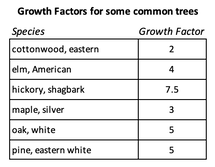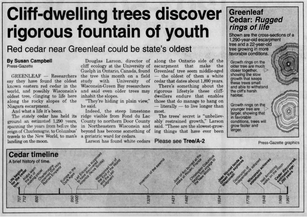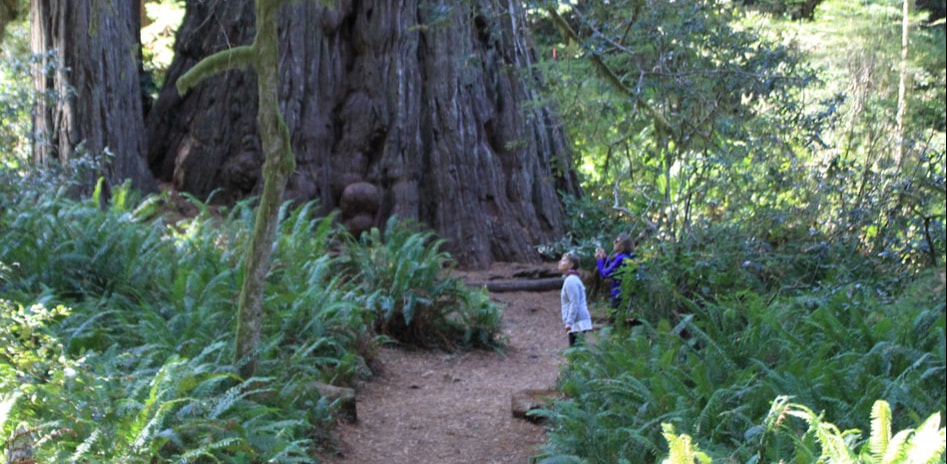|
Many of us feel a sense of admiration and adoration when we look upon an old or exceptionally large tree. Given many tree species live to ages well beyond human life expectancy, they can provide a connection to something larger than ourselves such as our ancestors, our moment in time, and our place in Nature. It is natural to have respect for our elders as they played a part in getting us to where we are today. The same can be said for the respect we have for old trees and old-growth forests given the many benefits we receive and role they play in healthy environments and ecosystems. A common question I am asked is, "how old is that tree?" Having studied and worked with trees for over 30 years, you’d think I’d be able to rattle off an age about as quickly as I can identify the type of tree it is. However, estimating the age of a tree simply by looking at it is nothing more than an educated guess at best, and we usually aren't privy to its growing conditions throughout its life. There are 3 primary ways we can estimate a tree's age. Two involve counting the annual growth rings and one uses a mathematical formula based on tree size. Counting tree rings tends to be more precise as size is not a reliable measurement eventhough trees generally get larger with age. However, this third method can often get us in the ballpark (albeit a rather large park). Having an idea of a tree’s age opens up the potential for admirers to build connection to and respect for some of Nature’s most amazing organisms and why I don’t mind engaging in the conversation.  An increment borer is a tool used by professionals who wish to view the annual growth rings of a tree. The tool is in essence a long metal tube with spiral teeth on the outer side, allowing it to be screwed into the trunk. Being a hollow cylinder, a “straw” or wood rod is captured inside the tube. When we remove this straw/rod, we have a cross-section of the growth rings. If you screwed into the center of the stem, you then have a rod that includes all of the growth rings. Not only can these rings be counted to help us determine the age of the tree, but also hold quite a bit of information that can be studied in order to help us look back in time.
Of course we don’t always hit the center of the stem. If your borer isn’t long enough to reach center, you miss the center, or should the middle of the tree be hollow, your extracted straw will not have all of the growth rings. In these instances, we may still be able to extrapolate the estimated age of the stem through calculating the average annual growth rate of the rings you did capture. Researchers, educators, and some tree fanatics will spend the money on this specialized equipment. The exact age of a tree has little impact when it comes to prescribing health related treatments, which is why this is not a standard piece of equipment used by arborists and related professions. Just Tell Me the Answer Since a tree’s age is a metric that often appeals to the general public and tree enthusiasts, there is another method that can be used to estimate ages. If we measure enough trees of a specific species, an average annual growth rate can be calculated for the species. Thanks to numerous research studies, this data has been used to generate growth factor values for a number of common tree species. This growth rate value is used in the following formula to estimate tree age: Growth Factor x DBH = Age The Growth Factor is basically the number of growth rings a species puts out per inch of trunk growth. The slower a tree grows, the more growth rings per inch, thus the higher the Growth Factor number. Faster growth leads to wider growth rings, therefore the Growth Factor will be a lower number relative to the size of the trunk (i.e. fewer rings per inch). DBH stands for “diameter at breast height”, which is a common measurement used when working with trees. In the most straight-forward of situations, the diameter, aka width of the trunk, is measured at 4.5 feet above the ground (breast/chest height).  Utilizing the Gorwth Factor chart and formula above; if you have a 10” diameter silver maple, your tree is likely to be about 30 years old (3.0 growth factor x 10”dbh = 30 years age). Remember, this only provides an estimate based on the average growth rate of silver maple. Depending on the growing conditions it developed under, I wouldn't be surprised if this tree is 20 years or even 50 years old. If the tree has been growing under fertile and ideal conditions, then growth rate can be greater and the tree younger in age. If the tree is growing under stressful conditions or in poor soil, then its rate of growth will be slower and an older age. (We'll look at an extreme example of this shortly!) To further complicate the matter, a tree is likely to experience years of greater growth and periods of slow growth throughout its lifetime. For example, trees that have a new home built next to them where construction equipment caused soil compaction to its root zone are likely to experience a period of slowed growth. The duration and extent of this negative impact is unknown in most cases and an example of why the formula method can only aid us in guess-timating a tree’s age. These examples are not meant to cause confusion, but rather aid in understanding why there can be such great variance when estimating age solely by tree size. Such variables can be taken into consideration when we are aware of them. When considering such variables, I typically offer an estimated age range that may span 25-50 years or more. If a ballpark estimate is good enough to satiate your curiosity, use the formula.  Click image to read more about the discovery of this tree. (External link to Wausau Daily Herald) Click image to read more about the discovery of this tree. (External link to Wausau Daily Herald) Growing Older But Not Up If trees get larger as they age, it may stand to reason that the largest trees are likely the oldest trees and vice versa. This is not usually the case, so let's consider this example. The oldest known tree in Wisconsin has been estimated close to 1,300 years old. (An increment borer was used for this estimation.) It is an eastern red cedar (Juniperus virginiana) with a trunk only 10 inches wide (10" dbh). This tree is growing on the side of a cliff. Growing out of cracks in the rock face is not exactly the best soil conditions for any tree, yet this tree has been able to survive while putting on very little growth per year. This demonstrates that the site conditions a tree is growing in can greatly influence its rate of growth considering an redcedar growing in ideal conditions could likely grow to a 10” diameter trunk within 50 years. This is in large part why trying to guess a tree’s age simply by looking at its size can be less than precise and why some professionals decline to provide age estimates. Is Age Just a Number I have enjoyed time amongst trees that sprouted in each of the last 4 millennia. I regularly visit a 200-250 year old bur oak, spending time in its branches thinking of all the changes it has seen in its lifetime. While we may not need to know the exact age of the tree, it is neat to be able to have an idea of how old a tree may be as knowing its age often instills a sense of admiration and connects us to previous generations and our point in history. A bur oak, not far from my house, recently had a large stem removed, revealing a 125-year history and an opportunity for reflection. Photos borrowed from:
0 Comments
|
AuthorAs a G.O.T.C. Recognized Master Instructor & Facilitator, I.S.A. Board Certified Master Arborist, and T.C.I.A. Certified Treecare Safety Professional, Curt has spent over 30 years dedicated to the study and care of trees. Categories
All
Archives
May 2024
|
|



 RSS Feed
RSS Feed
